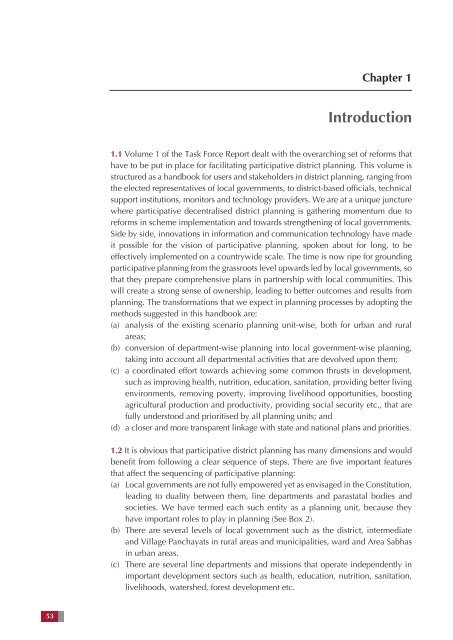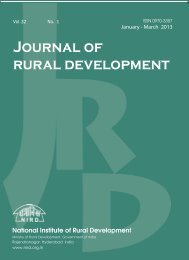Manual for Integrated District Planning - National Institute of Rural ...
Manual for Integrated District Planning - National Institute of Rural ...
Manual for Integrated District Planning - National Institute of Rural ...
Create successful ePaper yourself
Turn your PDF publications into a flip-book with our unique Google optimized e-Paper software.
Chapter 1<br />
Introduction<br />
1.1 Volume 1 <strong>of</strong> the Task Force Report dealt with the overarching set <strong>of</strong> re<strong>for</strong>ms that<br />
have to be put in place <strong>for</strong> facilitating participative district planning. This volume is<br />
structured as a handbook <strong>for</strong> users and stakeholders in district planning, ranging from<br />
the elected representatives <strong>of</strong> local governments, to district-based <strong>of</strong>ficials, technical<br />
support institutions, monitors and technology providers. We are at a unique juncture<br />
where participative decentralised district planning is gathering momentum due to<br />
re<strong>for</strong>ms in scheme implementation and towards strengthening <strong>of</strong> local governments.<br />
Side by side, innovations in in<strong>for</strong>mation and communication technology have made<br />
it possible <strong>for</strong> the vision <strong>of</strong> participative planning, spoken about <strong>for</strong> long, to be<br />
effectively implemented on a countrywide scale. The time is now ripe <strong>for</strong> grounding<br />
participative planning from the grassroots level upwards led by local governments, so<br />
that they prepare comprehensive plans in partnership with local communities. This<br />
will create a strong sense <strong>of</strong> ownership, leading to better outcomes and results from<br />
planning. The trans<strong>for</strong>mations that we expect in planning processes by adopting the<br />
methods suggested in this handbook are:<br />
(a) analysis <strong>of</strong> the existing scenario planning unit-wise, both <strong>for</strong> urban and rural<br />
areas;<br />
(b) conversion <strong>of</strong> department-wise planning into local government-wise planning,<br />
taking into account all departmental activities that are devolved upon them;<br />
(c) a coordinated ef<strong>for</strong>t towards achieving some common thrusts in development,<br />
such as improving health, nutrition, education, sanitation, providing better living<br />
environments, removing poverty, improving livelihood opportunities, boosting<br />
agricultural production and productivity, providing social security etc., that are<br />
fully understood and prioritised by all planning units; and<br />
(d) a closer and more transparent linkage with state and national plans and priorities.<br />
1.2 It is obvious that participative district planning has many dimensions and would<br />
benefit from following a clear sequence <strong>of</strong> steps. There are five important features<br />
that affect the sequencing <strong>of</strong> participative planning:<br />
(a) Local governments are not fully empowered yet as envisaged in the Constitution,<br />
leading to duality between them, line departments and parastatal bodies and<br />
societies. We have termed each such entity as a planning unit, because they<br />
have important roles to play in planning (See Box 2).<br />
(b) There are several levels <strong>of</strong> local government such as the district, intermediate<br />
and Village Panchayats in rural areas and municipalities, ward and Area Sabhas<br />
in urban areas.<br />
(c) There are several line departments and missions that operate independently in<br />
important development sectors such as health, education, nutrition, sanitation,<br />
livelihoods, watershed, <strong>for</strong>est development etc.<br />
53

















